Small business owners and the shops, services, and factories they run are significant sources of job creation. This fact is even more prominent in the Rocky Mountain region. In Colorado, New Mexico and Wyoming, owners of small businesses employ about one-third of all workers, compared with 28% nationally. Because they are such a large source of hiring, the experiences of small businesses throughout the pandemic, and the prospects for their recovery in recent months, are critical to the broader labor market recovery. Although “small” businesses are similar in that they are each small in size, their experiences in the latest economic downturn are as varied as the different communities they serve and services they provide. In this issue of the Rocky Mountain Economist we show how the types of small businesses that have remained open shifted over the past year and examine what that means for how this segment of the economy participates in the ongoing recovery.
Throughout the region the number of applications for new businesses soared during 2020, surpassing the level of entrepreneurship that emerged from the healthy economy the region enjoyed a year prior. In contrast, the number of small business owners – the self-employed workers that also typically hire a small workforce – was restrained from the onset of the pandemic into the early months of 2021. For many of these small business owners, shutting down led to unemployment not only for themselves but for their employees as well. At face value, the surge that resulted in twice as many new business applications nationwide in 2020 may appear to have offset the loss in jobs that resulted from the shuttering of 600,000 small businesses late in the year. However, the many small businesses in leisure & hospitality, manufacturing and transportation that closed typically employed four to five additional workers, whereas the online retailers that accounted for the new business application boom typically do not hire additional workers. In short, the small-business engine of job creation generally remained idle until recent months.
That started to change this spring when the types of small businesses that drive job growth started to participate more fully in the recovery. As consumer activity picked up on the heels of rising vaccination rates and lower levels of new COVID cases (prior to the emergence of the Delta variant), more business owners began to emerge, particularly in the leisure & hospitality and construction sectors. By June, the number of active small business owners had begun to approach pre-pandemic levels, though it may be some time before many of these businesses hire back the same size workforce.
The delayed recovery of small businesses until the middle of this year highlights the sensitivity of a key source of hiring to the path of the pandemic. It also renews the focus on the uneven experiences that small and large businesses in the Rocky Mountain region may have as the new Delta variant casts uncertainty about the path ahead.
Small Business Job Creation in the Rocky Mountain Region
Many of the small businesses across our local economies are run by individuals who also work full-time at their own business. This allows us to see the changes in outcomes for small businesses by tracking the self-employed entrepreneurs who run them using information in the U.S. Census Bureau’s Current Population Survey. In total, 10% of all workers in the United States were self-employed at the beginning of 2020. These 16 million workers either ran incorporated businesses or worked as independent contractors at unincorporated businesses. Although there generally are fewer small businesses that are fully incorporated, these more formal enterprises account for the bulk of small business job creation. Chart 1 contrasts the typical hiring at incorporated small businesses for the Rocky Mountain region and the U.S., as a share of the labor force over the last five years.
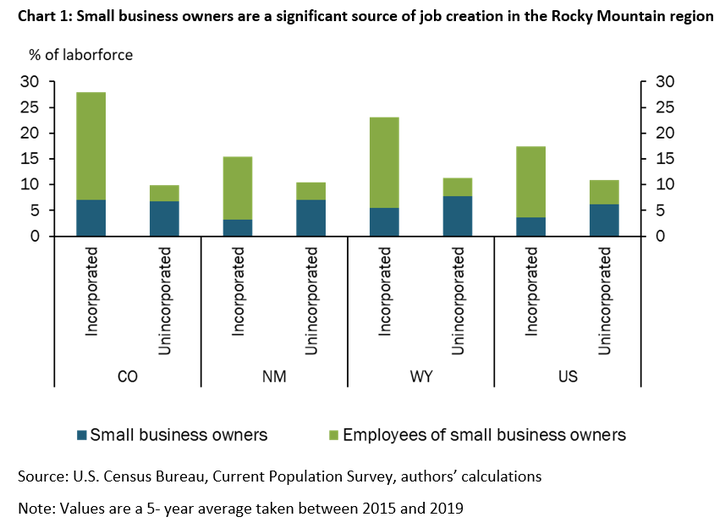
Three facts stand out. First, hiring by formal incorporated small businesses is significantly larger than other small businesses, as indicated by the green bars for each geographic region. The incorporated small businesses are both more likely to have employees at all, and also tend to hire a larger number of employees when they do maintain a workforce. Though it varies widely, on average, these small businesses typically hire between four and five additional workers. Second, hiring by small businesses is a substantial source of overall employment. More than a quarter of the U.S. workforce, totaling 28 million employees on average over the last half decade, either run or work at an incorporated small business. Third, in Colorado and Wyoming, the share of total employment at small businesses moderately exceeds the U.S. average making this segment of the economy even more important regionally.
Survival and Entrepreneurship Among Small Businesses
At the onset of the most recent downturn, the number of formal small businesses nationwide remained stable, likely due, in part, to the unprecedented policy support available to dampen the effects of the pandemic. (Chart 2.) As fiscal policy, monetary policy and regulatory flexibility provided aid early in 2020, most of the 6 million incorporated small businesses – those that employ many workers – remained open. Yet, the upward trend in entrepreneur activity over the last decade stalled, and many surviving businesses may have reduced the size of their workforce.i. Coming into 2021 more than 500,000 small business owners succumbed to the challenges wrought by the pandemic, presumably laying off their workforces as they shut down.
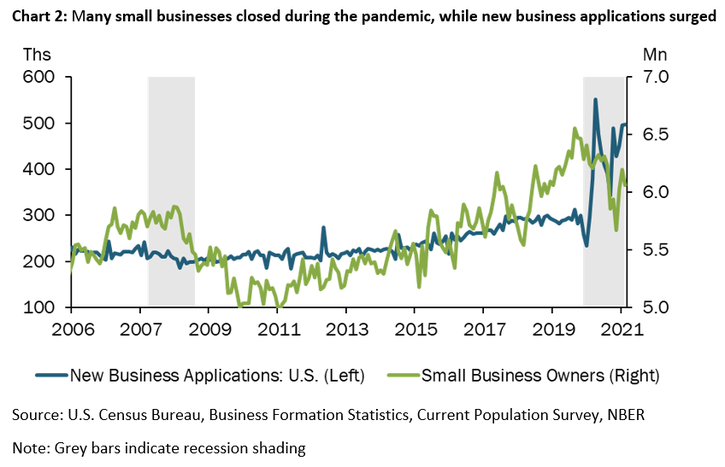
At the same time that small business activity stalled, the number of applications filed for new businesses climbed quickly and remained elevated for several months in 2020, as is shown in Chart 2. In total, over 4 million potential new businesses were being formed or transformed, which could have been an indication that lost jobs at small businesses might quickly resurface at newly created enterprises. However, Chart 3 shows that in the Rocky Mountain region these new potential businesses did not resemble those that typically hire additional workers. Across Colorado, New Mexico and Wyoming the bulk of new businesses either did not indicate plans for hiring a workforce on their application or come from industries where small businesses typically do not hire employees. Less than one-third of applications suggested that the new businesses would have a “high propensity” of having a workforce in each state.ii.
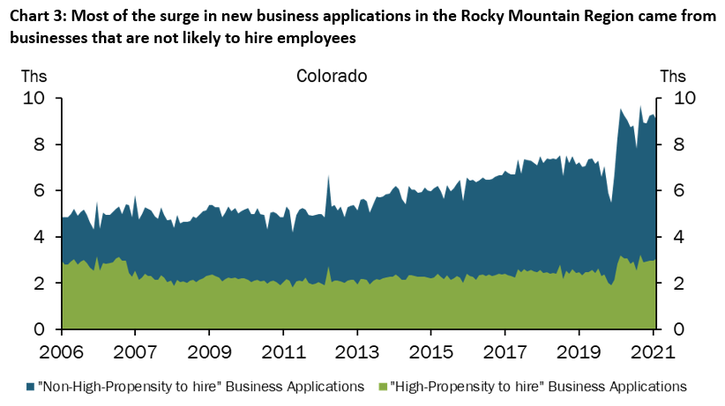
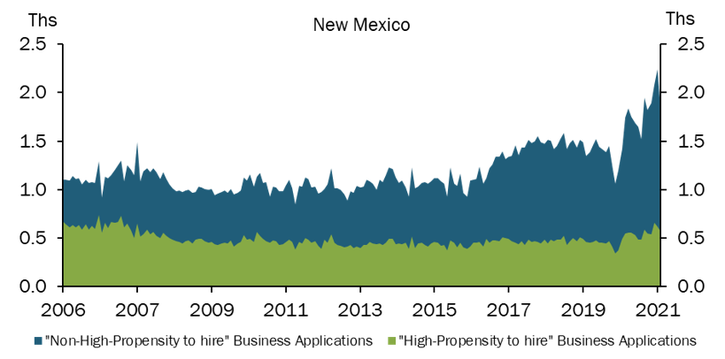
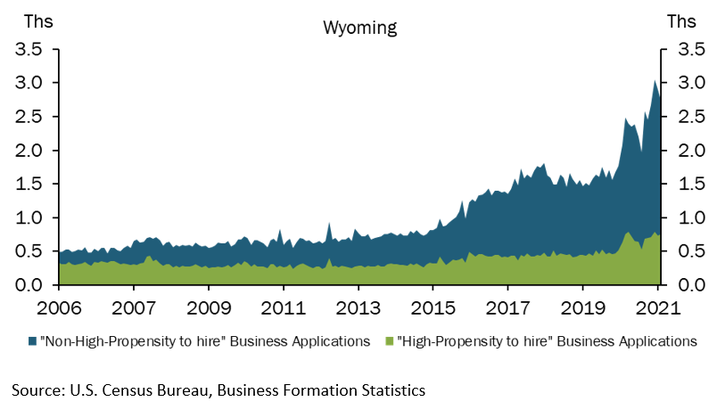
To be more specific, the surge in new business applications over the last year came predominantly from the retail sector, in particular, the online retail segment as small business owners adapted to serve customers remotely. (Chart 4.) The burgeoning online retail activity likely provided a crucial alternative source of revenue for businesses that closed their doors amid social distance measures. Yet, these small businesses are less likely to be a significant source of hiring.
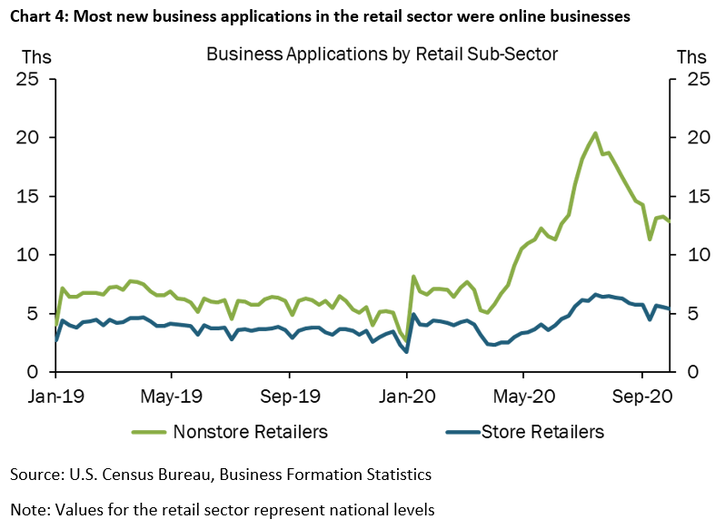
Even if the new online retail businesses did recruit workers, these jobs would look somewhat different from the lost jobs at small businesses. Chart 5 shows the change in the share of businesses that have employees from before the pandemic to the last several months. Most notably the leisure & hospitality, manufacturing and transportation sectors accounted for much of the job loss as fewer of these small businesses reported having employees in 2021. Though some of the skills workers possesses might transfer from these industries to retail, the job opportunities between these sectors certainly differ.
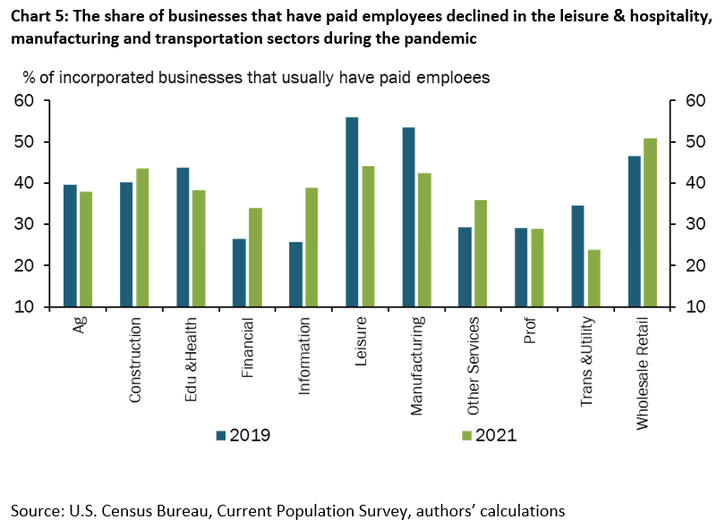
Small business activity began to normalize in March of this year, with 500,000 more individuals reporting that they were self-employed and running their own small business by mid-year. (Recall Chart 2.) Importantly, this nascent recovery among small business owners arises in the leisure & hospitality and construction sectors, parts of the small business community that tend to employ a large number of workers. If each of these businesses rehires the average number of four or five workers, this may be an indication that the small business engine of job growth is beginning to rev up.
Reference
i. Small business owners that respond to the CPS report only the “usual” number of workers they employ. As a result, we cannot gauge the actual number of jobs lost at small businesses over the past year.
ii. Since new business applications include filings for mergers and other reorganizations, the share of actual newly formed businesses that have a high propensity of hiring workers may be even lower than reported.
